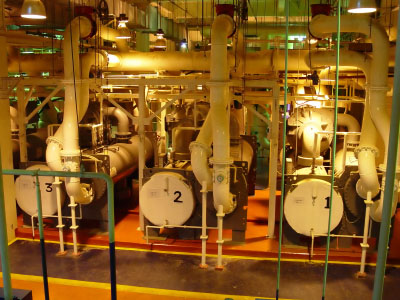Oral presentation of this web page.
Hot Water Heating Circuit, What is a hot water heating circuit, How does a hot water heating circuit work

The hot water heating circuit speaks to what is a hot water heating circuit and how does a hot water heating circuit work within a building.
The heating circuit consists of:

The purpose of the primary and secondary circuit water pumps are to provide water flow for:

The heating circuit water flow is designed to match the required flow rate of the mechanical components and the boilers.
Pumps
Pumps are now usually installed with circuit balance valves (CBV) at the discharge of the pump. The valve allows water flow to be measured and balanced to design flow rates.
The pumps must be in operation for the boilers to fire.
Heating Circuit Excess Pressure Control Loop
A bypass automatic control which senses the differential pressure between the supply and return line may be provided to maintain a constant pump head pressure at the circulating pumps.
A control positions a normally closed two port pneumatic valve to the open or closed position. It answers to increases or decreases in differential pressure in the heating system.
The fluctuations in system differential pressure are a result of the opening and closing of two way control valves throughout the building. The increased pressures developed at low heating demands must be throttled as control valves open and close causing objectionable noise.
The bypass control valve should be located in the crossover pipe between the supply and return water lines on the discharge side of the circulating pumps and the boiler return.
Heating Circuit Expansion Tank
The primary and secondary circuit heating water expansion tank allows for the fluctuation in the volume of water in the system as the water temperature changes.
Under normal operating conditions the tank level should not rise above the top or drop below the bottom of the sight glass. The sight glass is mounted on the side of the expansion tank.
A compressed air line connection is provided to the tank which allows for pressurization of the expansion tank. The pressurization of the system serves three purposes:
Heating Circuit Makeup Water System
The makeup water system consists of:
If the PRV malfunctions and allows more makeup water into the system than necessary, then the pressure relief valve will open and allow the system to drain until the excess is released.
The relief valves are each set above the system design operating pressure and should not be adjusted.
The shut off valves are used to isolate the PRV should it ever malfunction. The bypass valve may be opened manually to add water whenever the level drops too low or until the PRV is repaired and put back into service.
Double check valves are provided at the domestic cold water line connection to the pressure regulating valve to prevent chemically treated water from entering the cold water system, in the case of reverse flow.
Heating Water Chemical Treatment
Chemicals necessary to treat the heating water may be added to manually or automatically. It is usually a manual function in most applications. However, on more sophisticated systems water may be automatically tested and chemical added automatically.
The chemicals my be added to either the heating water supply or return line.
It is suggested that chemical tests be performed on a weekly basis to determine chemical concentration and that conditions be maintained as directed by a chemical treatment specialist. Chemical treatment is necessary to inhibit rust and corrosion of the water side of all heating water components.
Returm from Heating Circuit to Homepage
Hard copy and E book for sale. Introduction to Building Mechanical Systems. Click here.